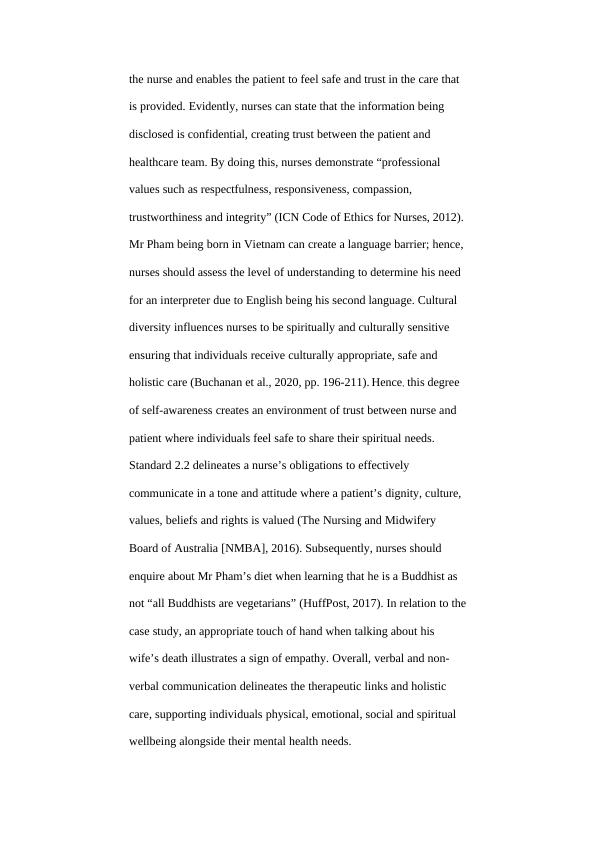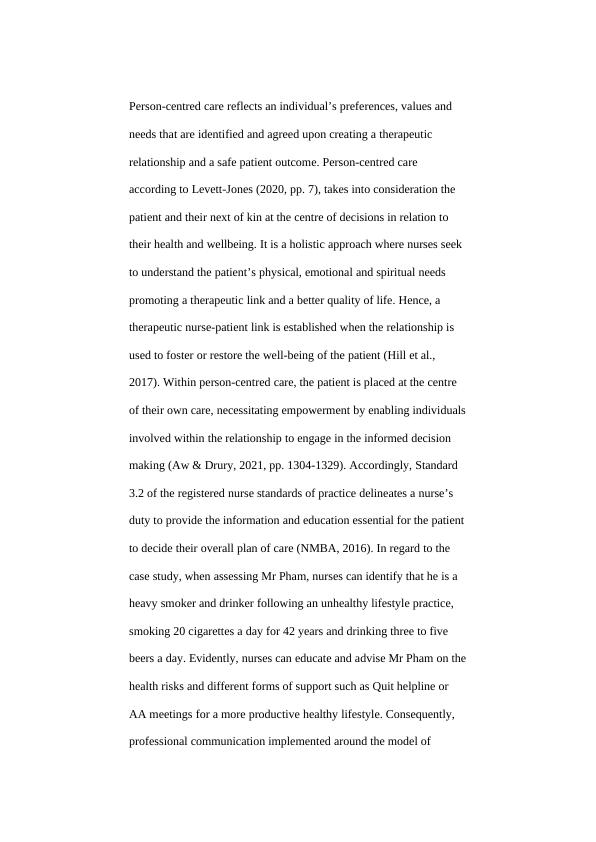Productive Cmmunication Skills
7 Pages1658 Words30 Views
Added on 2021-08-17
Productive Cmmunication Skills
Added on 2021-08-17
ShareRelated Documents
Professional communication is an essential skill for all nurses to
provide holistic and high-quality care. Productive communication
skills enable nurses to focus on a patient’s needs, developing
therapeutic links to provide safe patient outcomes. The development
of nurse-patient relationships where patients disclose information
allows nurses to accurately assess and diagnose patients to plan and
implement appropriate interventions. Furthermore, the case study of
George Pham, a 73-year-old male, will be used to illustrate the
relevance of professional communication in nursing practice and its
importance for holistic and high-quality care. The essay will explore
the three concepts of verbal and non-verbal communication skills,
person-centred care and effective documentation illustrating how
professional communication is critical for cultivating therapeutic
relationships and patient safety.
Effective communication skills, verbally or non-verbally, is crucial
towards patient safety and therapeutic nurse-patient relationships.
Verbal communication refers to the involvement of words where it
can be either written or spoken. Whereas non-verbal communication
are ways individuals communicate without using language through
gestures such as waving or sign language (Levett-Jones, 2019, pp.
196-211). Effective nurse-patient communication through sharing
information helps promote a therapeutic link assisting nurses to
understand the patient’s preferences regarding their environment
(Conroy et al., 2017, pp. 53). This creates a shared understanding for
provide holistic and high-quality care. Productive communication
skills enable nurses to focus on a patient’s needs, developing
therapeutic links to provide safe patient outcomes. The development
of nurse-patient relationships where patients disclose information
allows nurses to accurately assess and diagnose patients to plan and
implement appropriate interventions. Furthermore, the case study of
George Pham, a 73-year-old male, will be used to illustrate the
relevance of professional communication in nursing practice and its
importance for holistic and high-quality care. The essay will explore
the three concepts of verbal and non-verbal communication skills,
person-centred care and effective documentation illustrating how
professional communication is critical for cultivating therapeutic
relationships and patient safety.
Effective communication skills, verbally or non-verbally, is crucial
towards patient safety and therapeutic nurse-patient relationships.
Verbal communication refers to the involvement of words where it
can be either written or spoken. Whereas non-verbal communication
are ways individuals communicate without using language through
gestures such as waving or sign language (Levett-Jones, 2019, pp.
196-211). Effective nurse-patient communication through sharing
information helps promote a therapeutic link assisting nurses to
understand the patient’s preferences regarding their environment
(Conroy et al., 2017, pp. 53). This creates a shared understanding for

the nurse and enables the patient to feel safe and trust in the care that
is provided. Evidently, nurses can state that the information being
disclosed is confidential, creating trust between the patient and
healthcare team. By doing this, nurses demonstrate “professional
values such as respectfulness, responsiveness, compassion,
trustworthiness and integrity” (ICN Code of Ethics for Nurses, 2012).
Mr Pham being born in Vietnam can create a language barrier; hence,
nurses should assess the level of understanding to determine his need
for an interpreter due to English being his second language. Cultural
diversity influences nurses to be spiritually and culturally sensitive
ensuring that individuals receive culturally appropriate, safe and
holistic care (Buchanan et al., 2020, pp. 196-211). Hence, this degree
of self-awareness creates an environment of trust between nurse and
patient where individuals feel safe to share their spiritual needs.
Standard 2.2 delineates a nurse’s obligations to effectively
communicate in a tone and attitude where a patient’s dignity, culture,
values, beliefs and rights is valued (The Nursing and Midwifery
Board of Australia [NMBA], 2016). Subsequently, nurses should
enquire about Mr Pham’s diet when learning that he is a Buddhist as
not “all Buddhists are vegetarians” (HuffPost, 2017). In relation to the
case study, an appropriate touch of hand when talking about his
wife’s death illustrates a sign of empathy. Overall, verbal and non-
verbal communication delineates the therapeutic links and holistic
care, supporting individuals physical, emotional, social and spiritual
wellbeing alongside their mental health needs.
is provided. Evidently, nurses can state that the information being
disclosed is confidential, creating trust between the patient and
healthcare team. By doing this, nurses demonstrate “professional
values such as respectfulness, responsiveness, compassion,
trustworthiness and integrity” (ICN Code of Ethics for Nurses, 2012).
Mr Pham being born in Vietnam can create a language barrier; hence,
nurses should assess the level of understanding to determine his need
for an interpreter due to English being his second language. Cultural
diversity influences nurses to be spiritually and culturally sensitive
ensuring that individuals receive culturally appropriate, safe and
holistic care (Buchanan et al., 2020, pp. 196-211). Hence, this degree
of self-awareness creates an environment of trust between nurse and
patient where individuals feel safe to share their spiritual needs.
Standard 2.2 delineates a nurse’s obligations to effectively
communicate in a tone and attitude where a patient’s dignity, culture,
values, beliefs and rights is valued (The Nursing and Midwifery
Board of Australia [NMBA], 2016). Subsequently, nurses should
enquire about Mr Pham’s diet when learning that he is a Buddhist as
not “all Buddhists are vegetarians” (HuffPost, 2017). In relation to the
case study, an appropriate touch of hand when talking about his
wife’s death illustrates a sign of empathy. Overall, verbal and non-
verbal communication delineates the therapeutic links and holistic
care, supporting individuals physical, emotional, social and spiritual
wellbeing alongside their mental health needs.

Person-centred care reflects an individual’s preferences, values and
needs that are identified and agreed upon creating a therapeutic
relationship and a safe patient outcome. Person-centred care
according to Levett-Jones (2020, pp. 7), takes into consideration the
patient and their next of kin at the centre of decisions in relation to
their health and wellbeing. It is a holistic approach where nurses seek
to understand the patient’s physical, emotional and spiritual needs
promoting a therapeutic link and a better quality of life. Hence, a
therapeutic nurse-patient link is established when the relationship is
used to foster or restore the well-being of the patient (Hill et al.,
2017). Within person-centred care, the patient is placed at the centre
of their own care, necessitating empowerment by enabling individuals
involved within the relationship to engage in the informed decision
making (Aw & Drury, 2021, pp. 1304-1329). Accordingly, Standard
3.2 of the registered nurse standards of practice delineates a nurse’s
duty to provide the information and education essential for the patient
to decide their overall plan of care (NMBA, 2016). In regard to the
case study, when assessing Mr Pham, nurses can identify that he is a
heavy smoker and drinker following an unhealthy lifestyle practice,
smoking 20 cigarettes a day for 42 years and drinking three to five
beers a day. Evidently, nurses can educate and advise Mr Pham on the
health risks and different forms of support such as Quit helpline or
AA meetings for a more productive healthy lifestyle. Consequently,
professional communication implemented around the model of
needs that are identified and agreed upon creating a therapeutic
relationship and a safe patient outcome. Person-centred care
according to Levett-Jones (2020, pp. 7), takes into consideration the
patient and their next of kin at the centre of decisions in relation to
their health and wellbeing. It is a holistic approach where nurses seek
to understand the patient’s physical, emotional and spiritual needs
promoting a therapeutic link and a better quality of life. Hence, a
therapeutic nurse-patient link is established when the relationship is
used to foster or restore the well-being of the patient (Hill et al.,
2017). Within person-centred care, the patient is placed at the centre
of their own care, necessitating empowerment by enabling individuals
involved within the relationship to engage in the informed decision
making (Aw & Drury, 2021, pp. 1304-1329). Accordingly, Standard
3.2 of the registered nurse standards of practice delineates a nurse’s
duty to provide the information and education essential for the patient
to decide their overall plan of care (NMBA, 2016). In regard to the
case study, when assessing Mr Pham, nurses can identify that he is a
heavy smoker and drinker following an unhealthy lifestyle practice,
smoking 20 cigarettes a day for 42 years and drinking three to five
beers a day. Evidently, nurses can educate and advise Mr Pham on the
health risks and different forms of support such as Quit helpline or
AA meetings for a more productive healthy lifestyle. Consequently,
professional communication implemented around the model of

End of preview
Want to access all the pages? Upload your documents or become a member.
Related Documents
THE PROFESSIONAL COMMUNICATION IN NURSINGlg...
|6
|1287
|24
Effective Communication in Nursinglg...
|7
|1429
|91
Effective Professional Communication in Nursing Case Study 2022lg...
|7
|1599
|15
Assignment - Professional Communication in Nursinglg...
|6
|1469
|20
Professional Communication for nursinglg...
|7
|1562
|29
Importance of Effective Nurse-Patient Communication in Therapeutic Relationship and Patient Safetylg...
|7
|1610
|72
